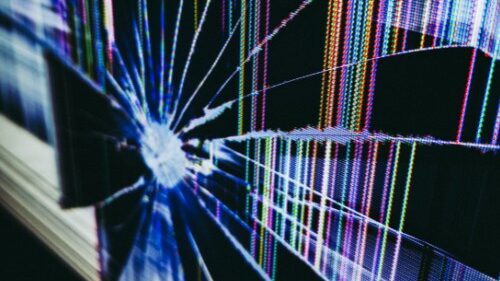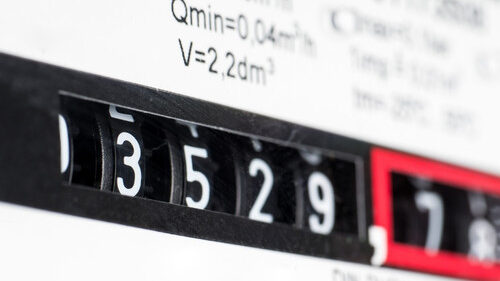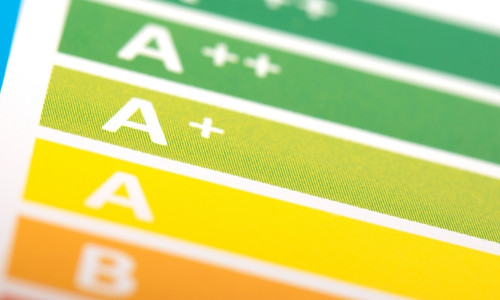The EU Ecodesign Directive and its consequences
From March 2023, the European Union will implement a ban on the sale of certain TV models due to their comparatively high energy consumption. After that, all 8K TVs and some high-quality 4K models could disappear from the market if the regulation remains in its current form. In this guide, we take a closer look at which TVs are affected by this measure, what manufacturers can do to prepare for it, how the new limits are defined and where the problems lie.
More sustainability through the EU Ecodesign Directive
The second stage of adapting the legal requirements for the energy consumption of electrical appliances will come into force on March 1, 2023. The aim of the new regulation is to improve sustainability. As part of a mandatory amendment to the Ecodesign Directive, the measure aims to minimize the negative environmental impact of electronic devices. Insiders also see this as a long-needed measure to reduce electronic waste.

Alongside numerous other product groups, televisions are clearly in the spotlight as one of the biggest power guzzlers in our households. In future, the EU Ecodesign Directive will therefore place even greater obligations on TV manufacturers to make their portfolios more energy-efficient and thus permanently banish power guzzlers from their model range.
In addition to a general reduction in the power consumption of certain appliance groups, the aim is also to improve the recyclability of such products and reduce CO2 emissions. In the meantime, it was not clear whether the EU would actually go through with its planned course. However, it now seems certain that it will be introduced.
Prospective buyers should therefore be aware that this may limit the availability of certain models and that certain makes may soon no longer be available. If you have still got your desired model but are still looking for suitable speakers, then take a look at our soundbar buying guide.
What are the new limits?
The so-called energy efficiency index indicates how high the power consumption of a TV set may be in relation to a certain screen diagonal. The surface area can be determined from the respective size as one of the decisive calculation factors.
It is important to differentiate between SDR and HDR operating modes. In the former, consumption is often much lower and is decisive for the rating. Power consumption in brighter HDR mode, on the other hand, is currently irrelevant.
To help you quickly determine whether or not the EU has given the green light for your current desired model or a TV you have already purchased, we have summarized all commercially available screen diagonals in a compact table with the corresponding maximum consumption for you.
If we do not list a screen size, you can also calculate the corresponding maximum consumption yourself using the following – not entirely straightforward – formula:

To explain: The parameter“P-measured” refers to the energy consumption specified by the manufacturer. The area of the screen is inserted at“A“. The variable“corr” stands for the correction factor and will no longer play a role in the calculation in future.
| Screen size | Maximum consumption (SDR) |
|---|---|
| 32 inch | 33 watts |
| 40 inch | 48 watts |
| 42 inch | 53 watts |
| 46 inch | 61 watts |
| 48 inch | 66 watts |
| 50 inch | 71 watts |
| 55 inch | 84 watts |
| 60 inch | 98 watts |
| 65 inch | 112 watts |
| 75 inch | 141 watts |
| 77 inch | 148 watts |
| 83 inch | 164 watts |
| 85 inch | 169 watts |
| 88 inch | 178 watts |
Do exceptions still apply?
A decisive factor is actually due to various exceptional cases that have applied up to now and prevented a whole range of TV sets from being unplugged earlier. However, this fact will soon change and the corresponding special regulations will no longer apply.
So far, so-called Micro-LED displays and 8K panels have been exempt from the requirements of the directive and therefore had no specific requirements in terms of their energy efficiency. However, these screens are considered to be particularly energy-intensive and are the televisions most affected by the Ecodesign Directive. OLED models also have the advantage that a correction factor is built into the calculations of the maximum permitted power consumption.
This aspect takes into account the fact that such displays are – at least theoretically – particularly energy-efficient and can therefore have a higher power consumption than other screens. However, this assumption is not practical. In many cases, self-illuminating pixel technology is not really more energy-efficient than LED-TVs.

From March 2023, both the correction factor just described and the exceptions for displays with 8K resolution and Micro-LED displays will no longer apply. This means that all of the above-mentioned model types will also have to comply with the requirements of the regulation in order to continue to receive a sales license in retail.
However, the EU still makes a distinction. All screens designed for professional use are fully exempt from the regulations. This applies to industrial screens, displays for control, measurement, monitoring and testing as well as CAD, graphics and video editing. The broadcasting sector is also exempt at this point.
Which TV models are affected in detail?
The new EU Ecodesign Directive not only affects Micro LED TVs and 8K TVs, but also some current 4K models on the market. We have compiled an overview of these TVs and their respective power consumption in SDR mode for you below.
According to EU regulations, these TVs from the top brands from model years 2021 and 2022 are no longer allowed to be sold at the time of writing:
| Manufacturer | Model name | Size in inches |
|---|---|---|
| LG | NANO96 | 65″ |
| LG | NANO99 | 65″, 75″ |
| LG | OLED Z1 | 77″, 88″ |
| LG | OLED Z2 | 77″, 88″ |
| LG | QNED96 | 65″, 75″ |
| Philips | OLED 936 | 48″, 55″, 65″ |
| Samsung | Neo QLED QN900A | 65″, 75″, 85″ |
| Samsung | Neo QLED QN800A | 65″, 75″, 85″ |
| Samsung | Neo QLED QN700A | 55″, 65″, 85″ |
| Samsung | Neo QLED QN900B | 65″, 75″, 85″ |
| Samsung | Neo QLED QN800B | 65″, 75″, 85″ |
| Samsung | Neo QLED QN700B | 55″, 65″, 85″ |
| Samsung | S95B QD-OLED | 55″, 65″ |
| Sony | Z9J | 75″, 85″ |
| Sony | A95K QD-OLED | 65″ |
Note in our Versus tool
In addition, we have supplemented our TV comparison with a color and textual note, which is displayed directly below the article image. This allows you to see at a glance whether a model complies with the guide values that will apply from March 2, 2023.
All televisions that may continue to be sold are marked in green. A red marking would prohibit sales as of 16.01.2023 in future. Our ecodesign section also provides you with further information on the power consumption of your TV set.
Fluctuating power consumption of TVs
The power consumption of televisions can vary greatly. They depend on various factors such as size, resolution and the type of panel. It also plays a role whether the TV has Internet access and therefore has the additional classification of Smart TV or not. Other important aspects are the effective brightness setting and the selected operating mode.

If we take all these key figures into account, the power consumption of a modern TV can – in the best case – average less than 50 kWh over 1000 hours of operation. For large 8K models at the maximum brightness level and highest resolution, however, this can easily mean more than 10 times the power consumption.
The range is therefore quite wide. However, as the stipulated threshold values are significantly lower, the much higher consumption will ultimately become a sales hurdle for manufacturers. Micro LED TVs also require a comparatively high amount of energy and could therefore also fail to meet the requirements. However, displays of this type have so far been reserved for the business sector and are therefore not a factor in private households.
What can TV manufacturers do about this?
Manufacturers have little leeway to avoid potentially being stuck with devices. In general, manufacturers such as LG, Samsung and Sony can adapt the software of the TV sets affected by the directive. Based on a picture mode specially designed for the EU Ecodesign Directive, the device would then be just below the prescribed consumption values as soon as you switch on the TV at home for the first time.
This trick is one way of circumventing the sales ban. The downside of this approach: After the initial start-up, the picture performance would not correspond to the quality or brightness at the retailer’s due to a darker display in conjunction with the low power consumption and would have to be adjusted subsequently.
Effects on consumers
The new regulations could have a negative impact in many respects and present consumers with an undesirable challenge that could ultimately end in irritation or resentment. Industry insiders assume that the implementation in its current form will have a major impact on the TV industry and force consumers to buy older, less powerful models.
Assuming that manufacturers do indeed add a special operating mode, buyers could end up being the “victims”. Retailers would have to make consumers aware of the EU Ecodesign Directive in connection with the picture settings in advance. Consumers often rely on the fact that a purchased device works “correctly” as soon as it is set up.

In the worst case scenario, the unsuspecting average consumer simply returns the newly purchased television because the conversion process seems too complex and important information has been passed on incorrectly or not at all. Damage to the manufacturer’s image is also conceivable as a further consequence.
Even a quick guide that flies through the box somewhere would probably only be noticed by very few buyers or even read properly. A striking adhesive label on the screen that explains in a few simple steps what the user needs to do to be able to use the device to its full potential would be better. Whether and in what way such assistance will be implemented remains pure speculation at the moment.
Loud criticism from all sides
Realignment necessary
At the time of defining suitable limit values for the EU Ecodesign Directive, there were no reference values for technologies such as 8K. Screen diagonals of 65 inches and more were hardly an issue for private households.
High contrasts and frequencies that now exceed 120 hertz per second were also still a thing of the future in the following years. The demand from manufacturers, associations and organizations is designed to persuade the EU to change its position and redefine the permitted values accordingly. To achieve this, the necessary adjustments must be made and the regulation must be aligned with the current conditions on the TV market.
This also includes the call to exclude Micro-LED TVs and 8K televisions from the outset. The reason: these technologies are not yet so widespread in Europe, meaning that the higher energy consumption of comparatively few devices – measured against the overall sales market – does not play a significant role.
Hardly any better efficiency values
Even the adjustment of the energy efficiency label in March 2021 is hardly a practicable solution for consumers. As televisions have not made the expected leaps in terms of energy efficiency in recent years, even current models are grouped into one of the two worst categories in most cases.

Technologies such as OLED or 8K are not considered in a differentiated manner and, in addition to power consumption, the luminance in the as-delivered state is also included in the assessment. The TV must achieve either at least 65 percent of its peak brightness or 220 Candela per square meter over its entire surface.
In plain language, the new EU Ecodesign Directive means that almost three quarters of all TV sets will be awarded the G energy label. Less than 20 percent achieve the F rating. This makes the distinction more difficult for consumers, as although the exact consumption values are generally comparable, there is no clear reference factor for classification.
Two decisive reasons are relevant in this context: Firstly, the efficiency increase of 7.5 percent per year assumed by the EU deviates significantly from reality. Secondly, the implementation of technologies such as HDR and increased screen resolution has meant that electricity consumption has risen continuously for several years instead of falling.
As a result, many TVs no longer just fall into a single efficiency class, but will no longer be able to meet the standard that will apply from March 1, 2023. In order to comply with the limit values, all 8K devices, for example, would have to reduce their energy consumption by up to 50 percent and thus halve it. This will not be technically feasible in the coming years.
The directive as a damper on investment
As part of the EU Ecodesign Directive, the aim was to promote the use of energy-efficient appliances. This makes sense in order to reduce energy consumption and minimize environmental impact. However, this directive can also hinder the development of new technologies.

Display manufacturers often invest in new developments such as 8K panels or Micro-LED displays. However, especially in the introductory phase, such trends are often rightly perceived by consumers as unnecessary, as they are too expensive for normal use and therefore quickly appear superfluous. Nevertheless, it is right and important to continue developing these technologies, as they will be a part of our lives in the future.
In the long term, the current version of the EU Ecodesign Directive may mean that display manufacturers no longer invest so much money in new technologies, as only a small proportion of these investments can be recouped. This could slow down the development of new technologies.
Sources:
- https://presse.lg.de/2023/01/04/ces-2023-lg-oled-tv-mit-zero-connect-technologie-definiert-raumgestaltung-neu/
- https://www.digitaleurope.org/resources/can-tv-monitors-and-display-technology-become-even-more-energy-efficient/
- https://www.digitaltrends.com/home-theater/eu-efficiency-standards-would-ban-8k-4k-tvs/
- https://www.umweltbundesamt.de/umwelttipps-fuer-den-alltag/elektrogeraete/fernseher




